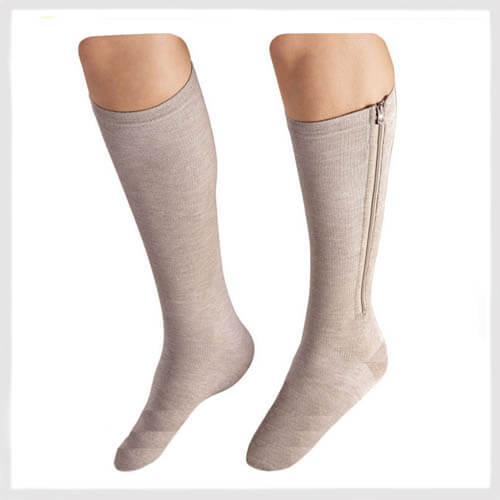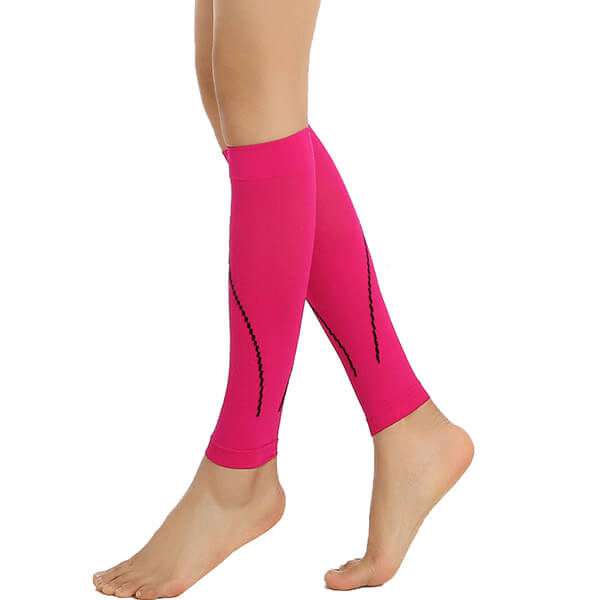Unter Elizabeth Quinn
Kompressionssocken gibt es schon lange, aber erst in den letzten Jahren haben Sportler die eng anliegenden Kniestrümpfe in ihre Trickkiste für Leistung und Erholung aufgenommen. Helfen Kompressionssocken also bei der sportlichen Leistung oder bei der Regeneration?
Kompressionskleidung, einschließlich Strümpfen, Socken, Ärmeln und Wickeln, wurde in erster Linie entwickelt, um die Durchblutung bei Patienten nach Operationen, Diabetikern, Personen mit Durchblutungsstörungen oder Personen, die zu Schwellungen (Ödemen) und Venenentzündungen neigen, zu verbessern, krampfadernund tiefe Venenthrombose (DVT).
Bei diesen inaktiven und bettlägerigen Patienten unterstützen die eng anliegenden Beinwickel den Rückfluss des Blutes zum Herzen, damit es sich nicht in den unteren Extremitäten staut und Schwellungen verursacht. Die Kompression reduziert außerdem Risiko von Blutgerinnseln.
Sportler begannen mit der Verwendung von Kompressionsstrümpfen in der Hoffnung, ähnliche Vorteile hinsichtlich einer verbesserten Durchblutung zu erzielen. Zunächst trug eine kleine Handvoll Läufer die engen Strümpfe nach dem Training und dann bei längeren Ausdauerläufen. Die anekdotischen Berichte über eine schnellere Erholung, eine verbesserte Laufleistung und weniger Muskelkater bei der Verwendung von Kompressionssocken häuften sich, und mit ihnen entstand eine lange Liste potenzieller Vorteile von Kompressionssocken.
Leistung
Es wurde angenommen, dass das Tragen der Socken während des Sports die Leistung verbessert, die Sauerstoffzufuhr und die Durchblutung erhöht, die Erschütterungen, Vibrationen und die Belastung der Muskeln verringert und Weichteilschäden wie Schienbeinkantensyndrom.
Einige Athleten waren der Meinung, dass die zusätzliche Kompression um die Waden und Knöchel ebenfalls hilfreich war. Propriozeption und sogar das Gleichgewicht verbessert. Man hoffte auch, dass die Verbesserung des venösen Blutflusses und die zusätzliche Kompression der Wadenmuskulatur zu einer verbesserten Ausdauer, einer effizienteren Muskelfunktion und schnelleren Laufzeiten führen würden.
Einige, aber nicht alle dieser Theorien haben sich in der Forschung bewahrheitet. Der Großteil der Studien hat noch keine statistisch signifikanten Leistungsunterschiede beim Tragen von Kompressionssocken festgestellt. Einige wenige Studien berichten von verbesserten Laufzeiten während Ultra-Endurance-Veranstaltungen bei einigen Sportlern, aber der Großteil der Forschung hat keine dramatischen Vorteile bei der Verwendung von Kompressionssocken zur Verbesserung der sportliche Leistung, Wettkampfzeiten oder Ausdauer. Bislang ist der Nutzen des Tragens von Kompressionsstrümpfen während des Trainings unklar, aber einige Sportler sind davon überzeugt, dass es ihnen hilft.
Erholung
Wenn es um das Tragen von Kompressionsstrümpfen für die sportliche Erholung geht, zeichnet die Forschung ein etwas anderes Bild: Eine wachsende Zahl von Studien deutet darauf hin, dass die Verwendung von Kompressionsstrümpfen in der Tat möglich ist, Geschwindigkeitswiederherstellung und verringern den Muskelkater nach einem anstrengenden Training. Die Ergebnisse variieren, aber der Trend deutet auf einen Rückgang der gemeldeten Muskelkater und möglicherweise weniger Muskelschäden und eine schnellere Erholung, wenn nach dem Training Kompressionssocken getragen werden. Einige Studien stützen auch die Theorie, dass das Tragen von Kompressionssocken während intensiver Ausdauerläufe, plyometrische Übungen oder Sprinttrainingkann auch den von Sportlern berichteten Muskelkater nach dem Training verringern.
Denken Sie daran, dass die genaue Messung des Muskelkaters eine schwierige Angelegenheit ist, und dass die Bewertung des Muskelkaters, den ein Sportler nach dem Training verspürt, subjektiv und schwer zu quantifizieren ist. Außerdem gibt es die sehr reale Placebo-Effekt die manche Athleten beim Tragen von Kompressionskleidung erleben können. Der psychologische Auftrieb und der Glaube, dass die Kleidung die Regeneration verbessern kann, können zusammen mit dem Gefühl der Kompression einen größeren Einfluss auf die Wahrnehmung des Schmerzes durch den Sportler haben. Und wie jeder Sportler weiß, kann das, was wir glauben, einen sehr realen Einfluss auf unsere Leistung haben.
Auch wenn Kompressionsstrümpfe nicht für alle Athleten in jeder Situation das Wundermittel für eine bessere Leistung und eine schnellere Erholung sind, können sie für einige Athleten unter den richtigen Umständen eine weitere gute Erholungshilfe darstellen.
Die aktuellen Empfehlungen von Experten und Athleten scheinen darauf hinzudeuten, dass Athleten durch das Tragen von Kompressionsstrümpfen bei langen, harten Ausdauerwettkämpfen eine leichte Steigerung der mechanischen Leistungsfähigkeit erfahren können. Wahrscheinlicher ist, dass die Verwendung von Kompressionsstrümpfen ein weiteres Instrument zur Unterstützung der Erholung während der 24 Stunden nach einem harten Training oder Wettkampf darstellt.
Die richtige Passform
Um die Vorteile von Kompressionsstrümpfen zu nutzen, ist das richtige Maß an Kompression entscheidend. Sie sollte am Knöchel enger sein und die Kompression zum Knie hin allmählich abnehmen. Achten Sie also darauf, dass Sie sich vor dem Kauf von Kompressionskleidung an die Passformhinweise des Herstellers halten. Die ideale Kompression wird immer noch erforscht, aber die aktuellen Studien deuten darauf hin, dass eine Kompression von etwa 15-25 mmHg ideal ist, solange sie abgestuft ist (etwas mehr Druck am Knöchel und weniger, wenn man das Bein nach oben bewegt). Eine zu starke Kompression kann die Blutzirkulation beeinträchtigen, und eine zu geringe Kompression bringt nur wenig Nutzen, so dass es darauf ankommt, die richtige Einstellung zu finden.
Wenn Sie Kompressionsstrümpfe kaufen, müssen Sie Ihren Waden- und Knöchelumfang messen, nicht Ihre Schuhgröße. Die meisten Marken auf dem Markt bieten eine ähnliche Passform. Befolgen Sie jedoch die Anweisungen des Herstellers und verwenden Sie die für Ihren Wadenumfang empfohlene Größe, um den richtigen Kompressionsdruck zu erhalten.
Sie sind sich immer noch nicht sicher, ob sie eine echte Trainingshilfe oder nur eine weitere Modeerscheinung sind? Der beste Weg, um herauszufinden, ob die Socken funktionieren, ist wahrscheinlich, sie selbst auszuprobieren und zu sehen, was Sie davon halten. Sie sind vielleicht nicht für jeden geeignet, aber sie schaden sicher nicht Ihrer Erholung.









